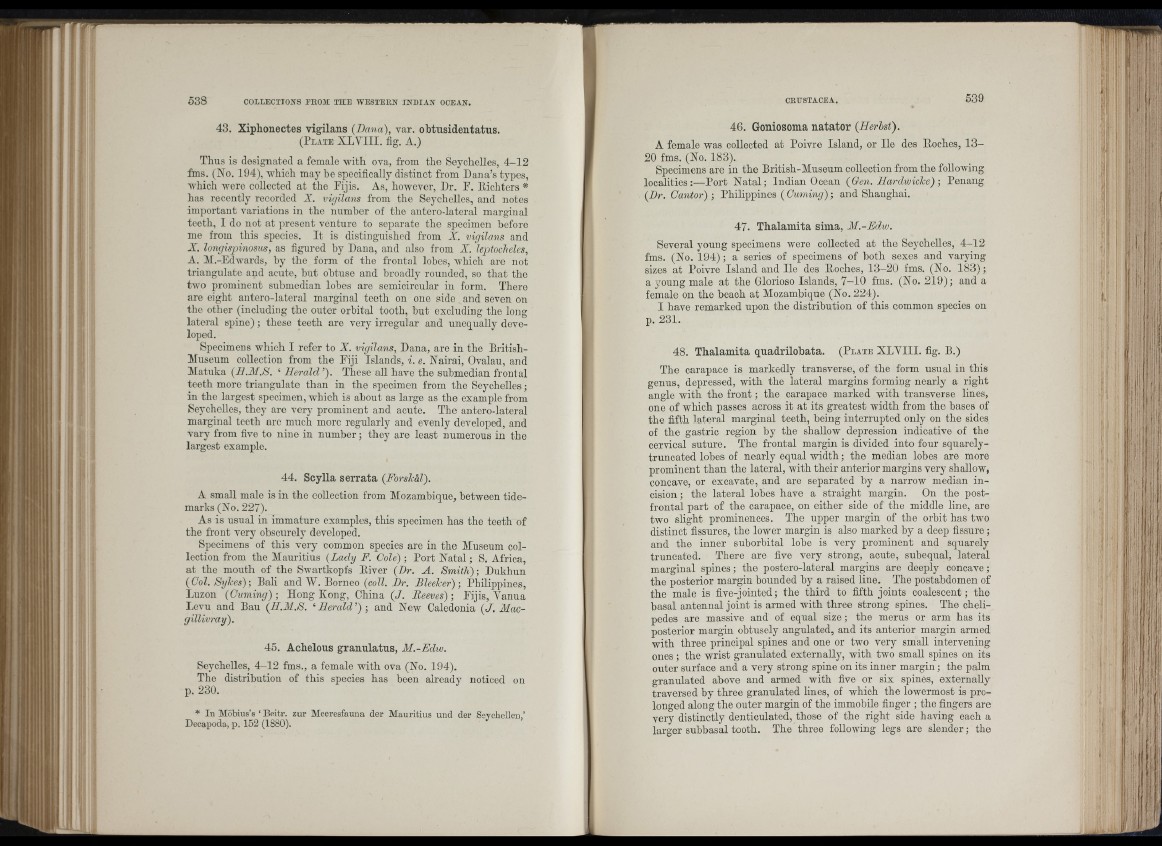
ill
ill
43. Xipbonectes vigilans (Dana), var. obtnsidentatus.
(P late X LV III. fig. A.)
Thus is designated a female witb ova, from tbo Seychelles, 4—12
fms. (Xo. 194), wbicb may be specifically distinct from Dana’s types,
Avbich were collected at tbe Eijis. As, however, Dr. F. Eichters *
has recently recorded X. vigilans from the Seychelles, and notes
important variations in tbe number of tbe antero-lateral marginal
tcctb, I do uot at present venture to separate tbe specimen before
me from this species. I t is distinguished from X. vigilans and
X longispinosus, as figured by Dana, and also from X. leptocheles,
A. Al.-Edwards, by the form of the frontal lobes, wbicb are not
triangulate and acute, bnt obtuse and broadly rounded, so th at tbe
two prominent submedian lobes are semicircular in form. There
are eight antero-lateral marginal tcetli on one sideband seven on
the other (including tbe outer orbital tooth, but excluding tbe long
lateral spine); these teeth arc very irregular and unequally developed.
Specimens which I refer to X. vigilans, Dana, are in tbe British-
AInseum collection from tbe Eiji Islands, i. e. Nairai, Ovalau, and
Alatuka (H.Al.S. ‘ Herald ’). These all have tbe submedian frontal
teeth more triangulate than in the specimen from the Seychelles;
in the largest specimen, which is about as large as tbe example from
Seychelles, they are very prominent and acute. The antero-lateral
marginal teeth are much more regularly and evenly developed, and
vary from five to nine in n umber; they are least numerous in tbe
largest example.
44. Scylla serrata (Forskal).
A small male is in tbe collection from Mozambique, between tidemarks
(No. 227).
As is usual in immature examples, tbis specimen has the teeth of
the front very obscurely developed.
Specimens of tbis very common species are in tbe Aluseum collection
from tbe Mauritius (Lady F. Cole) ; Port N a ta l; S. Africa,
at the mouth of the Swartliopfs Eiver (Br. A . Smith); Dukhun
(Col. Sykes); Bali and AV. Borneo (coll. Dr. Bleeker); Philippines,
Luzon (Cuming); Hong Kong, China (J. Beeves); Eijis, Vanua
Levu and Ban (H.A1.S. ‘•H e ra ld ); and New Caledonia (J. Alacgillivray).
45. Achelous granulatus, M.-Edw.
Seychelles, 4-12 fms., a female witb ova (No. 194).
The distribution of this species has been already noticed on
p. 230.
* In Mobius’s ‘ Beitr. zur Meeresfauna der Mauritius und der Seychellen ’
Decapoda, p. 152 (1880).
46. Goniosoma natator (Herhst).
A female was collected at Poivre Island, or He des Eoches, 1 3 -
20 fms. (No. 183).
Specimens are in tbe Britisb-Museum collection from tbe folloAving
localities:—Port Natal; Indian Ocean (Oen. Hardwicke); Penang
(Dr. Cantor); Philippines ( Cuminy); and Shanghai.
47. Thalamita sima, M.-Edw.
Several young specimens were collected at the Seychelles, 4 -12
fms. (No. 194); a series of specimens of both sexes and varying
sizes at Poivre Island and He des Eoches, 13-20 fms. (No. 183);
a 3’oimg male a t tbe Glorioso Islands, 7-10 fms. (No. 219); and a
female on tbe beach at Mozambique (No. 224).
I have remarked upon tbe distribution of this common species on
p. 231.
48. Thalamita quadrilobata. (P late XLVIII. fig. B.)
The carapace is markedly transverse, of tbe form usual in this
genus, depressed, witb tbe lateral margins forming nearly a right
angle with tbe fro n t; tbe carapace marked with transverse lines,
one of wbicb passes across it at its greatest width from tbe bases of
the fifth lateral marginal teeth, being interrupted only on tbe sides
of the gastric region by tbe shallow depression indicative of the
cervical suture. The frontal margin is divided into four squarely-
truncated lobes of nearly equal w id th ; tbe median lobes are more
prominent than tbe lateral, witb tbeir anterior margins very shallow,
concave, or excavate, and are separated by a narrow median incision;
tbe lateral lobes have a straight margin. On tbe postfrontal
part of tbe carapace, on either side of tbe middle line, are
two slight prominences. The upper margin of tbe orbit has two
distinct fissures, the lower margin is also marked by a deep fissure;
and the inner suborbital lobe is very prominent and squarely
truncated. There are five very strong, acute, subequal, lateral
marginal spines; tbe postero-lateral margins are deeply concave;
tbe posterior margin bounded by a raised line. The postabdomen of
the male is five-jointed; the third to fifth joints coalescent; the
basal antennal joint is armed witb three strong spines. Tbe cbelipcdes
are massive and of equal size; tbe merus or arm has its
posterior margin obtusely angulated, and its anterior margin armed
witb three principal spines and one or two very small intervening
ones; the wrist granulated externally, with two small spines on its
outer surface and a very strong spine on its inner margin; the palm
granulated above and armed witb five or six spines, externally
traversed by three granulated lines, of which the lowermost is prolonged
along the outer margin of tbe immobile finger ; tbe fingers are
very distinctly denticulated, those of tbe right side having each a
larger subbasal tooth. The three folloAving legs are slender; tbe
i '